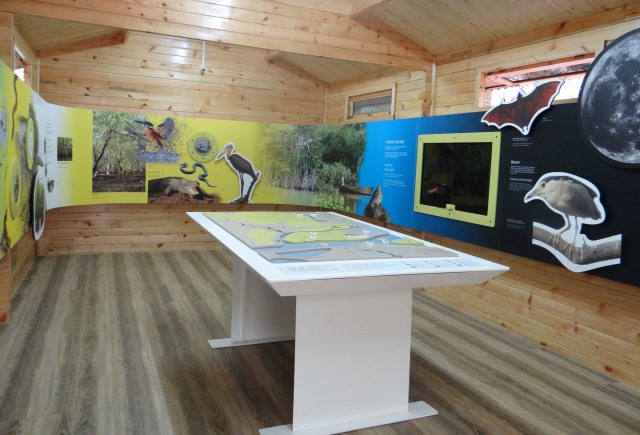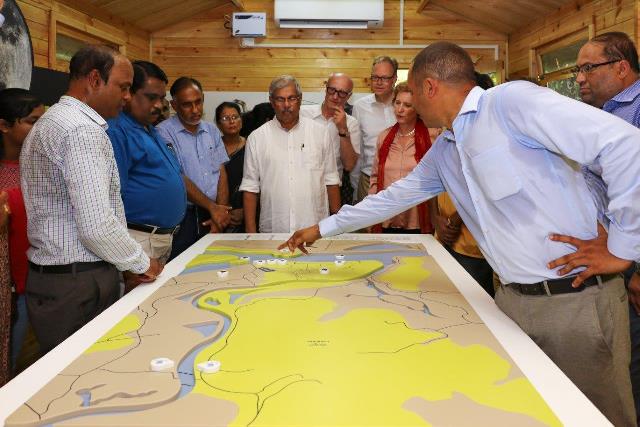19 Apr, 2016
This is something very useful and important for the island of Chorao. We knew that Chorao is rich in biological diversity such as birds and mangroves, but there was no way that we could have known specifically about their names and kinds. But now we can and in a manner where it can be easily understood by the general public. Also, I believe that the Interpretation Facilty will provide a boost to tourism in Chorao," shared Ms. Esperance Rodrigues, a resident of Chorao, as she made her way through the Mangrove Interpretation facility at the Dr. Salim Ali Bird Sanctuary.
.jpg)

The Mangrove Interpretation Facility was launched at Dr. Salim Ali Bird Sanctuary on 19 April, 2016
19 April, 2016 marked an important day for Chorao’s residents, as the Mangrove Interpretation facility was inaugurated by Mr. Anant V. Shet, Speaker, Goa Legislative Assembly, and Mr. Rajendra Arlekar, Minister of Forest, Panchayats, and Environment, Goa. This took place in the presence of Dr. Christiane Paulus, Deputy Director General, Nature Conservation Department, German Federal Ministry for the Environment, Nature Conservation, Building and Nuclear Safety (BMUB), as well as Mr. Michael Siebert, Consul General, German Consulate General, Mumbai.
.jpg)
(from left) Mr. Ajai Saxena, Mr. Edgar Endrukaitis, Mr. Anant Shet, , Mr. Rajendra Arlekar, Mr. Michael Siebert, Dr. Christiane Paulus, and Dr. Anil Kumar
The sanctuary is an important pilot site of the GIZ's CMPA Project, which is being jointly implemented by the Goa Forest Department, Ministry of Environment, Forest and Climate Change (MoEFCC), and GIZ since September 2014. The site was declared a sanctuary in 1998. Despite its small size, it has a very unique socio-ecological history, as it was entirely under rice cultivation less than 50 years ago. Besides birds, this sanctuary is home to a large variety of animals, which includes, the Mugger (Marsh crocodile), the Smooth-coated otter, and the Glossy Marsh snake.
.jpg)
Dr. Christiane Paulus being presented a sapling from the Goa Forest Department
The sanctuary, a pristine, fully protected area, is part of the Chorao Island, which is situated in close proximity to Goa’s capital city, Panaji. Inevitably, the sanctuary is impacted by the activities of the surrounding communities. As part of its communication strategy, the CMPA project is working with the people of Chorao to generate awareness about the unique ecology of the mangrove ecosystems and the important services they provide. To this end, the Mangrove Interpretation Facility at the Dr. Salim Ali Bird Sanctuary is one of the major interventions of the CMPA project.

Dr. Aaron Lobo describing the Chorao Island Habitats to the dignitaries
Dr. Aaron Lobo, GIZ Technical Advisor, took the dignitaries, and the invited guests on a guided tour through the facility, and provided additional information with respect to the various exhibits. He explained that all the information, including photos, was sourced locally to ensure authentic experience for the visitors. The launch was followed by an inaugural function in the Chorao village, which began with the screening of a short film titled titled ‘Chorao Island: A Place, its People and a Project,’ the film has been produced under the CMPA project. The short film beautifully showcased the rich biodiversity of Chorao, and its importance to the communities.
.jpg)
A visitor at a 'See-Through Panel'
During the inaugural programme, Dr. Paulus, Deputy Director General, Nature Conservation Department, shared that "the Government of Germany cooperates with many countries in the practical implementation of biodiversity conservation measures, and it was in line with this policy that it fostered a partnership with the Government of India, for the implementation of dedicated programmes, aimed at preserving India’s biodiversity. The CMPA project is a very important project for us, and it’s also the largest of its kind in India, and I am here to visit the different sites of the project. The opening of the Interpretation facility marks a milestone for BMUB and GIZ's CMPA project. The exhibitions represent the unique combination of local knowledge with international design."
.jpg)
A visitor looking for nocturnal animals using the 'Torch'
Mr. Rajendra Arlekar, Minister of Forest, Panchayats, and Environment, Goa, on the occasion added that " the setting up of the interpretation facility, with the assistance of the German Government is just the beginning for us. We are now looking forward to organising a bird festival, which will be the first of its kind in Goa."
.jpg)
Dr. Michael Vakily ( GIZ), and Mr. Jorg Schmidtsiefen (Archimedes) exploring the 'twist-It'
Mr. Michael Siebert, Consul General, German Consulate General, referred to the "interpretation facility as a significant symbol of strategic cooperation between India and Germany.” Mr Siebert further added that "the launch of the interpretation facility is an important step towards sustainable development, as it provides the opportunity to learn about nature, cherish our environment, preserve the ecosystem for future generations, while also being of value for tourism, and the possibility to generate income.”
The inaugural programme was concluded by Mr. Edgar Endrukaitis, Director, Indo-German Biodiversity Programme. He congratulated the residents of Chorao for their active participation in the conservation of their area , and he also acknowledged the support provided by the Ministry of Environment, Forest and Climate Change (MoEFCC), and the Goa Forest Department for the successful implementation of the CMPA project.
The CMPA project is part of the International Climate Initiative (IKI). The German Federal Ministry for the Environment, Nature Conservation, Building and Nuclear Safety (BMUB) supports this initiative on the basis of a decision adopted by the German Bundestag. The CMPA project is implemented by the Ministry of Environment, Forest and Climate Change (MoEFCC), Government of India, and the Deutsche Gesellschaft für Internationale Zusammenarbeit (GIZ) GmbH on behalf of BMUB.
Photo credits: Indo-German Biodiversity Programme, GIZ
© 2014 IGBP. All Rights Reserved.
Site By: Virtualpages
